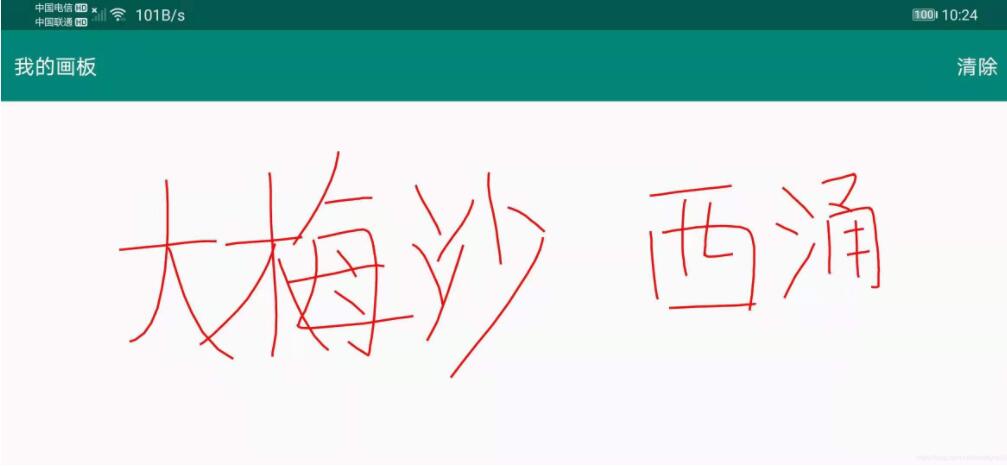Android实现画板功能(一)
本文实例为大家分享了Android实现画板功能的具体代码,供大家参考,具体内容如下
前言
最近看到了一些Android手写相关的功能,比如说:
钉钉手写签名功能,输入法手写功能,笔记类App的手写记录功能等。最近在工作中也遇到了类似的需求,其实实现画板功能并不复杂,所以我就打算在这里简单记录一下。实现画板功能比较常用的方法有两种,一是自定义view的方式在canvas上画轨迹,另一个是在imageview上画bitmap。今天就讲一下第一种方式吧。
效果图

界面布局
<RelativeLayout xmlns:android="http://schemas.android.com/apk/res/android"
xmlns:tools="http://schemas.android.com/tools"
android:layout_width="match_parent"
android:layout_height="match_parent"
tools:context=".MainActivity">
<RelativeLayout
android:layout_width="match_parent"
android:layout_height="55dp"
android:background="@color/colorPrimary">
<TextView
android:layout_width="wrap_content"
android:layout_height="wrap_content"
android:text="我的画板"
android:layout_marginStart="10dp"
android:layout_centerVertical="true"
android:textColor="@android:color/white"
android:textSize="16sp"/>
<TextView
android:id="@+id/text_clear"
android:layout_width="wrap_content"
android:layout_height="wrap_content"
android:text="清除"
android:layout_alignParentEnd="true"
android:layout_marginEnd="10dp"
android:layout_centerVertical="true"
android:textColor="@android:color/white"
android:textSize="16sp"/>
</RelativeLayout>
<com.example.drawline.LineView
android:id="@+id/lineView"
android:layout_marginTop="55dp"
android:layout_width="match_parent"
android:layout_height="match_parent">
</com.example.drawline.LineView>
</RelativeLayout>
代码是用kotlin写的,但是实现方法和java是一样的。新建一个自定义view类,继承自View。kotlin不需要写View的三个重载方法。只需把三个参数传给父类即可。
然后是初始化Paint,Path,设置画笔颜色等。
关键代码是在onTouchEvent里面,这里需要获取到手指的位置。在移动手指时调用Path的lineTo(x,y)方法记录一下轨迹,然后调用invalidate()方法实时更新画面即可,invalidate()方法会调用onDraw方法,onDraw方法里面调用Canvas的drawPath方法就可以画出手指划过的轨迹了。
清除轨迹要调用reset()方法,调用invalidate()方法。
自定义view类
package com.example.drawline
import android.annotation.SuppressLint
import android.content.Context
import android.graphics.*
import android.util.AttributeSet
import android.view.MotionEvent
import android.view.View
class LineView @JvmOverloads constructor(
context: Context,
attrs: AttributeSet? = null,
defStyleAttr: Int = 0
) : View(context, attrs, defStyleAttr) {
private val defaultPath: Path
private val defaultPaint: Paint
init {
defaultPath = Path()
defaultPaint = Paint(Paint.ANTI_ALIAS_FLAG or Paint.DITHER_FLAG)
defaultPaint.style = Paint.Style.STROKE
defaultPaint.strokeWidth = 5f
defaultPaint.color = Color.RED
}
override fun onDraw(canvas: Canvas) {
super.onDraw(canvas)
canvas.drawPath(defaultPath, defaultPaint)
}
@SuppressLint("ClickableViewAccessibility")
override fun onTouchEvent(event: MotionEvent): Boolean {
val x = event.x
val y = event.y
when (event.action) {
MotionEvent.ACTION_DOWN -> defaultPath.moveTo(x, y)
MotionEvent.ACTION_MOVE -> defaultPath.lineTo(x, y)
MotionEvent.ACTION_UP -> defaultPath.lineTo(x, y)
}
invalidate()
return true
}
fun clear(){
defaultPath.reset()
invalidate()
}
}
MainActivity
class MainActivity : AppCompatActivity() {
override fun onCreate(savedInstanceState: Bundle?) {
super.onCreate(savedInstanceState)
setContentView(R.layout.activity_main)
text_clear.setOnClickListener { lineView.clear() }
}
}
本篇文章中介绍了自定义view的一些基础知识,适合刚学习自定义view的同学们。后面几篇文章中将会继续深入讲解Android自定义view相关知识。
以上就是本文的全部内容,希望对大家的学习有所帮助,也希望大家多多支持我们。
赞 (0)

